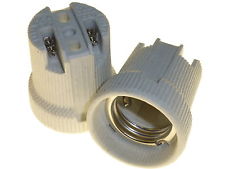

Metal halide lamps are a type of HID (High Intensity Discharge) lamp; mercury vapor and high-pressure sodium lamps are also HID lamps. HID lamp (High Intensity Discharge), which means it provides most of its light from the electric arc within a small discharge tube. It is becoming increasingly popular due to its good quality white light and good efficiency. The most prominent use of the MH lamp is in stadiums and sports fields. It is also used widely for parking lots and street lighting in urban areas,However, mercury vapor and sodium lamps are not typically used in the reef hobby but are widely used in the horticulture industry. The metal halide lamps used in the aquarium hobby are typically characterized and sold based on different attributes, such as:
The inner arc tube contains the electrodes and various metal halides, along with mercury and inert gases that make up the mix. The typical halides used are some combination of sodium, thallium, indium, scandium and dysprosium iodides. These iodides control the lamp’s spectral power distribution and provide color balance by combining the spectra of the various iodides used.

Expect professional grade performance from our HID metal halide lamps. Ideal in retail, commercial and residential applications, metal halide HID bulbs have a long life and produce a crisp white light perfect for areas where color rendering is critical. From standard metal halide bulbs to PAR shape pulse start MH lamps, our comprehensive product selection is sure to impress. Our HID metal halide lineup includes:
• Standard lamps
• Pulse start bulbs
• Ceramic lamps
• Teflon coated bulbs
• Double ended lamps
the manufacturer’s/lamp’s name;
the lamp’s nominal wattage;
the type of method used to mount the lamp, along with the number of ends in the sockets used to mount the lamps and;
the lamp’s color temperature.
Metal halide lamps have two basic configurations; those with an outer envelope and those without. In the former, the lamp’s basic construction is an inner envelope (called the arc tube), which contains the arc, and an outer envelope (called the bulb) which filters out ultraviolet radiation (UVR) and shields the inner arc tube. These lamps are typically single-ended (SE) and use a threaded mount to screw into a lamp socket. The second lamp configuration lacks the outer envelope and typically has two ends (double-ended, DE) that need to be inserted into a lamp socket, as we shall discuss shortly.
The metal halide ballast provides the proper starting voltage, operating voltage and current to the lamp to initiate and sustain the arc. HID lamps have a negative resistance characteristic, which causes them to draw an increasing amount of current, hence need a current limiting device. The ballast provides these functions. There are several different ballast types used for for HID lighting. Basically, there are two primary distinctions between ballasts: "lag circuit" and "lead circuit" ballasts. The current in lag type ballasts is controlled by an inductive resistance in series with the lamp, whereas in lead type ballasts it current control is provided by both inductive and capacitive resistances in series with the lamp.
James supply the lamp holders, bulb holders, E27 lamp holder and GU10 lamp holder 30 years!
Copyright @2012-2016 James Lighting Ceramics & Electronic CO.,LTD